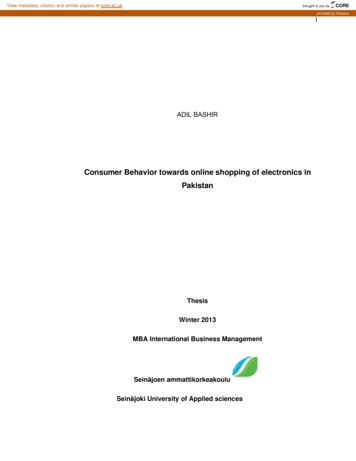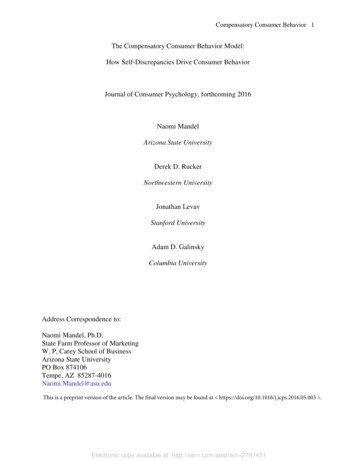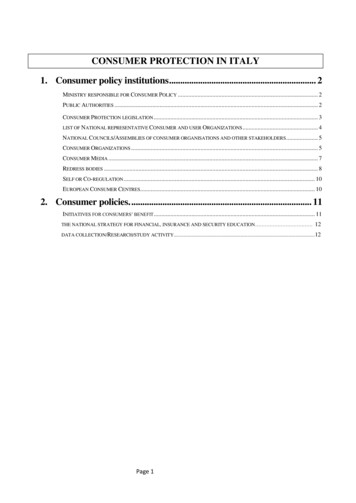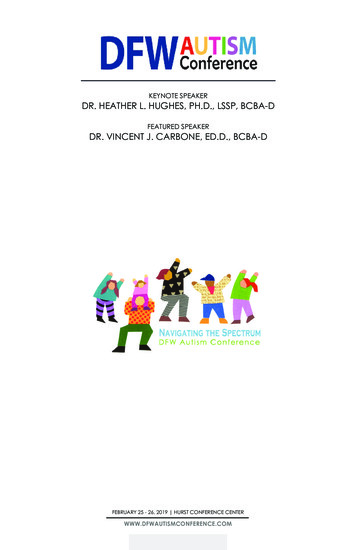
Transcription
American Recovery andReinvestment Act of 2009:Experiences from the ConsumerBehavior Studies on EngagingCustomersAUTHORS:Peter Cappers†, Richard Scheer††Energy Analysis and Environmental Impacts DivisionLawrence Berkeley National Laboratory†Scheer Ventures††September 2014LBNL-182975
DisclaimerThis document was prepared as an account of work sponsored by the United StatesGovernment. While this document is believed to contain correct information, neither theUnited States Government nor any agency thereof, nor The Regents of the University ofCalifornia, nor any of their employees, makes any warranty, express or implied, or assumesany legal responsibility for the accuracy, completeness, or usefulness of any information,apparatus, product, or process disclosed, or represents that its use would not infringeprivately owned rights. Reference herein to any specific commercial product, process, orservice by its trade name, trademark, manufacturer, or otherwise, does not necessarilyconstitute or simply its endorsement, recommendation, or favoring by the United StatesGovernment or any agency thereof, or The Regents of the University of California. Theviews and opinions of authors expressed herein do not necessarily state or reflect those ofthe United States Government or any agency thereof or The Regents of the University ofCalifornia. Ernest Orlando Lawrence Berkeley National Laboratory is an equal opportunityemployer.This report was prepared by Lawrence Berkeley National Laboratory for the Office ofElectricity Delivery and Energy Reliability, U.S. Department of Energy under LawrenceBerkeley National Laboratory Contract No. DE‐AC02‐05CH11231.FOR MORE INFORMATIONRegarding: Experiences from the Consumer Behavior Studies on Engaging Customers, pleasecontact:Peter CappersLawrence Berkeley National LaboratoryE-mail: PACappers@lbl.govRegarding the Smart Grid Investment Grant, please contact:Joseph PaladinoU.S. Department of EnergyE-mail: Joseph.Paladino@hq.doe.govhttp:/www.smartgrid.gov
U.S. Department of Energy September 2014AcknowledgementsThe United States Department of Energy would like to acknowledge the contributions of severalindividuals to this report. Rich Scheer of Scheer Ventures LLC and Peter Cappers of LawrenceBerkeley National Laboratory were the primary authors. The following people contributedperspectives, observations, and lessons learned based on their experiences implementingconsumer behavior studies under the Smart Grid Investment Grant Program. Jay Anderson, Marblehead Municipal Lighting DepartmentAmanda Beraldi, Green Mountain PowerCasey Bisard and Craig Boice, NV EnergyRandall Dotson and Jeffery Sprague, Lakeland ElectricMike Farrell, Oklahoma Gas and Electric CompanyTina Koecher, Minnesota PowerRebecca Leiter, Brandon McMillen, and Joanne Savage, First Energy CorporationLisa Morris and Shawn Enterline, Vermont Electric Cooperative and Sean Bleything,Vermont Energy Investment CorporationMary Beth Murray, DTE EnergyJennifer Potter and Lupe Strickland, Sacramento Municipal Utility DistrictLessons Learned – CBS Utilities Engagement with ConsumersPage i
U.S. Department of Energy September 2014Executive SummaryOne of the most important aspects for thesuccessful implementation of customer-facingprograms is to better understand how to engageand communicate with consumers. Customerfacing programs include time-based rates,information and feedback, load management,and energy efficiency.This report presentslessons learned by utilities through consumerbehavior studies (CBS) conducted as part of theDepartment of Energy’s (DOE) Smart GridInvestment Grant (SGIG) program.Under the American Recovery andReinvestment Act of 2009, the U.S.Department of Energy and theelectricity industry have jointlyinvested over 7.9 billion in 99 costshared Smart Grid Investment Grantprojects to modernize the electric grid,strengthen cybersecurity, improveinteroperability, and collect anunprecedented level of data on smartgrid and customer operations.The SGIG CBS effort presents a uniqueopportunity to advance the understanding of consumer behaviors in terms of customeracceptance and retention, and electricity consumption and peak demand impacts. The effortincludes eleven comprehensive studies with the aim of evaluating the response of residentialand small commercial customers to time-based rate programs implemented in conjunction withadvanced metering infrastructure and customer systems such as in-home displays,programmable communicating thermostats, and web portals. DOE set guidelines and protocolsthat sought to help the utilities design studies that would rigorously test and more preciselyestimate the impact of time-based rates on customers’ energy usage patterns, as well asidentify the key drivers that motivate behavioral changes.The studies consist of several phases: planning, recruiting customers to participate, operatingthe time-based rate programs, and conducting post-study evaluations to assess results anddetermine next steps, including possible large-scale roll-outs. To assist the studies, LawrenceBerkeley National Laboratory (LBNL) organized a series of monthly conference calls to provide aforum for the CBS utilities to exchange information, candidly discuss problems and solutions,and share ideas about what does and does not work when engaging consumers in the variousphases of study implementation To support others that may be interested in implementingtime-based rate and other customer-facing programs, LBNL and the utilities developed anumber of lessons learned and recommendations from these monthly discussions. Table ES-1provides a summary of the lessons learned.The utilities found that the lessons learned are more than just good things to do - they arepractical steps that should be taken by utilities and others to reduce risks and increaseLessons Learned – CBS Utilities Engagement with ConsumersPage ii
U.S. Department of Energy September 2014efficiencies, and thereby lower project costs, and increase the chances of successful outcomesin future studies and programs.Major FindingsIn addition to the twenty-two lessons learned presented in Table ES-1, there are four majorfindings: Consumer engagement activities should be ongoing, adequately funded, and integratedexplicitly into every phase of the studies to ensure success. Those CBS utilities whoundertook a substantial and dedicated level of effort in the early phases to promoteconsumer engagement, such as general customer education, market research, andstakeholder and community outreach, believe those activities paid significant dividends inthe subsequent customer recruitment and operations phases.Going forward, electric power industry stakeholders who are interested in providing timebased rate program offerings to customers (e.g., utilities, regulators, vendors, and thirdparty providers) need to employ comprehensive and consistent consumer engagementefforts for meeting the varied needs of all customers and stakeholders involved in theimplementation of time-based rate and related programs. Utilities should re-think organization and management approaches when implementingtime-based rates, either as studies, or perhaps more importantly, for larger-scale rollouts. The CBS utilities generally found, as have others who have been active in timebased rate programs, that implementation activities cross-cut a variety of utilitydepartments and functions and that skill sets are often lacking in key areas such asmarketing and market research. For example, several CBS utilities reported difficulties infinding expertise in building and operating data bases and management informationsystems to handle increasing amounts of customer data.When implementing time-based rate programs and related products and services,electric power industry stakeholders should apply techniques for greater internalcoordination through the use of cross-functional teams and other approaches tostrengthen organizational effectiveness. Many of the CBS utilities found theseapproaches to be highly beneficial. More effective strategies are needed for working with vendors and developers in therelatively immature customer-systems industry. All of the CBS utilities experienceddisconnects between what was said in brochures about device capabilities (such as inhome displays) and their actual performances in the field. As a whole, the electric powerLessons Learned – CBS Utilities Engagement with ConsumersPage iii
U.S. Department of Energy September 2014industry can view these experiences as emblematic of a broader array of challengeswhen developing and deploying new and emerging software systems and applications,many of which are new ventures, and where some come from small companies andstart-ups.Without short changing creativity and innovation, utilities need to find more effectiveways to work with vendors and ensure that fully verified and validated products andservices are the ones offered to customers. Utilities can improve their chances of success in implementing time-based rateprograms by communicating with each other in candid discussions during the course ofimplementing their studies and programs. It is true that the SGIG CBS effort representeda somewhat unique opportunity for DOE to play a role in fostering open and candidinformation exchanges among utilities that would not normally interact on a regular andconsistent basis. All of the CBS utilities said they valued the LBNL-facilitated forums verymuch and in several instances said they were able to implement ideas and lessonslearned from other utilities in their own efforts.Going forward, regions, states, and industry groups should consider taking on thisfunction to improve implementation efficiency, replicate best practices, and maximizethe use of resources by avoiding the repeat of common mistakes.Next StepsOver the next 18-24 months, DOE and LBNL are planning to publish additional reports on theresults of analysis of the SGIG CBS data and evaluation reports. Upcoming reports include:interim and final analysis reports on SGIG CBS project results including energy and peakdemand reductions, bill impacts, and customer acceptance/retention; how energy and peakdemand reductions vary over time (e.g., from event days to non-event days, from year one toyear two of the studies); how vulnerable populations such as low-income and elderly customersfared compared with other groups; and how alternative experimental designs (e.g., randomizedcontrolled trials vs. within-subjects) affect the precision and credibility of load impacts fromstudies of time-based rate programs. All of these publications will be posted onwww.smartgrid.gov. Appendix A contains web links to CBS materials and related reports.Lessons Learned – CBS Utilities Engagement with ConsumersPage iv
U.S. Department of Energy September 2014Table ES-1. Summary of Lessons LearnedStudy PhasesTopicsEducation andOutreachPlanningOrganization andManagementRecruitmentInfrastructureLessons Learned1.Conduct General Customer Education2.Conduct Market Research3.Test Messages before Using Them4.Implement Cross-functional Teams5.Have Friends and Family Participation6.Evaluate Systems Integration Requirements7.Verify Equipment Capabilities8.Be Prepared for Much More Customer Data9.Have Plans for Using Vendors and Call Centers10. Conduct Soft Launches and Avoid Holiday SeasonsRecruitment11. Use Multiple Delivery ChannelsRecruitment Strategies12. Set Realistic Expectations13. Avoid Confusing Messages14. Conduct Training for Communication SkillsNotifications andCommunicationsOperation15. Expect Notification Errors16. Use Web Portals as Active and not Passive ToolsMulti-Day, CriticalPeak Events17. Refine Notification Frequency to Avoid Confusion18. Have Plans for Addressing Customer Complaints19. Have Plans for Dealing with Customer DevicesEnding the Study20. Take Steps for Reaching ClosureEvaluationRoll-Out DecisionMaking21. Conduct Comprehensive Evaluations22. Educate Decision Makers about Evaluation ResultsLessons Learned – CBS Utilities Engagement with ConsumersPage v
U.S. Department of Energy September 2014Table of ContentsExecutive Summary. i1.Introduction . 12.Program Planning . 63.Customer Recruitment. 124.Program Operations. 185.Program Evaluations . 236.Major Findings and Next Steps . 27Appendix A – Where to Find Further Information . 30Lessons Learned – CBS Utilities Engagement with ConsumersPage vi
U.S. Department of Energy September 20141.IntroductionUnder the American Recovery and Reinvestment Act of 2009 (Recovery Act), DOE and theelectricity industry have jointly invested over 7.9 billion in 99 cost-shared SGIG projects tomodernize the electric grid, strengthen cybersecurity, improve interoperability, and collect anunprecedented level of data on smart grid technologies, tools, and techniques.1.1Overview of the Consumer Behavior StudiesThe SGIG program includes ten utilities that are conducting eleven consumer behavior studies(CBS). All of the studies produce interim and final evaluation reports and these are posted onDOE’s smartgrid.gov website. These reports contain additional details on the specific consumerengagement activities conducted by the various utilities. Figure 1 provides a summary of theSGIG CBS utilities and the technologies and rate offerings they have deployed. These two-yearstudies will be completed by the end of 2015. Appendix A contains web links to CBS and relatedreports.The SGIG CBS effort presents an opportunity to advance the electric power industry’sunderstanding of customer acceptance and retention, and energy and peak demand impacts,from participation in time-based rate programs by building on the existing and long-standingindustry experience with studies, experiments and pilots. This is valuable for determining howto use time-based rates for achieving demand reductions and deferring needs for futurecapacity additions.To increase the usefulness of the studies to others, DOE set guidelines and protocols for the tenutilities to: (1) focus their studies on the application and implementation of time-based rates(e.g., time of use, critical peak pricing); (2) apply experimental methods (e.g, randomizedcontrol trials, randomized encouragement designs); and (3) recruit sufficient numbers ofparticipants into the study.1The DOE guidelines and protocols sought to help the utilities design studies that wouldrigorously test and more precisely estimate the impact of time-based rates on customers’energy usage patterns, as well as identify the key drivers that motivate the changes. This wouldenable the studies, if implemented consistent with the design, to provide more definitiveanswers for policymakers and stakeholders to key questions in the areas of acceptance of and1Further information on methods for conducting studies of time-based rates and other types of customerprograms can be found in a report by Lawrence Berkeley National Laboratory (with funding from DOE) and theElectric Power Research Institute, “Quantifying the Impacts of Time-Based Rates, Enabling Technologies, andother Treatments in Consumer Behavior Studies: Guidelines and Protocols”, July 2013.Lessons Learned – CBS Utilities Engagement with ConsumersPage 1
U.S. Department of Energy September 2014response to time-based rate programs. Each utility was assigned a Technical Advisory Group toprovide technical assistance which would help the utilities better adhere to the DOE guidelinesand protocols.Two of the studies are complete, the rest are at different phases of study implementation.Overall, the aim of the studies is to examine the response of residential and small commercialcustomers to time-based rate programs which are implemented in conjunction with thedeployment of AMI and customer systems such as in-home displays (IHDs), programmablecommunicating thermostats (PCTs), and web portals.The purpose of this report is to present lessons learned by the CBS utilities about one of themost important aspects of implementing customer-facing programs: how to effectively engageand communicate with customers. The lessons learned consist of recommendations andsuggestions for planning and operating time-based rate programs in conjunction with AMI andcustomer systems, recruiting customers to participate, and conducting post-programevaluations to support decision making for follow-on, larger-scale, roll-outs.The lessons learned are based on a series of discussions and in-depth interviews with theutilities facilitated by Lawrence Berkeley National Laboratory (LBNL). Beginning in 2010, LBNLhas organized a series of monthly conference calls to provide a forum for the CBS utilities toexchange information, candidly discuss problems and issues, and share ideas about what doesand does not work within the various phases of program implementation. During the monthlyCBS forums consumer engagement activities have consistently been one of the top prioritytopics for discussion.Lessons Learned – CBS Utilities Engagement with ConsumersPage 2
U.S. Department of Energy September 2014Figure 1. SGIG Consumer Behavior Studies1.2Study Implementation PhasesFor the purposes of these studies, discussions were organized according to four phases thatgenerally define the sequence of implementing studies of time-based rate programs: (1)planning (2) recruitment, (3) operation, and (4) evaluation (Figure 2). There are consumerengagement activities in each of the phases and this report presents information on CBS utilityExpectations and Experiences (e.g., initial conditions and observations) and Lessons Learned(i.e., suggestions and recommendations about what to do and not do).Lessons Learned – CBS Utilities Engagement with ConsumersPage 3
U.S. Department of Energy September 2014Figure 2. Phases of Study ImplementationThe first phase involves planning of consumer engagement activities undertaken prior torecruitment to understand what motivates customers to join programs and take service undertime-based rates. This phase can include: market research (e.g., surveys and focus groups) togain a better understanding of levels of consumer awareness, interests, and needs about smartmeters, time-based rates and customer systems; general consumer education activities aboutthese topics; and outreach to specific stakeholders and community groups to better educatetarget audiences and identify/address their concerns.The second phase involves recruitment of customers to join the study of time-based rate orinformation programs. This phase can include: development and delivery of study invitationpackages; processes and tools for addressing customer questions about the study; andmanagement and organizational activities for building needed administrative processes andsystems.The third phase involves operation of consumer engagement activities undertaken afterrecruitment is complete and during the period when the study is being implemented and delivered.This phase can include development and use of: systems for notifying customers of pricing levelsand/or demand response (e.g., critical peak) events; information about how to manageconsumption and bills; processes and procedures for addressing customer questions, concerns, andattrition; and activities for operating the management and administrative processes related tocustomer engagements.Lessons Learned – CBS Utilities Engagement with ConsumersPage 4
U.S. Department of Energy September 2014The last phase involves evaluation of the study to understand what was learned so as to informdecisions about future plans for potentially larger-scale roll-outs. This phase can include:implementation and analysis of customer acceptance surveys and energy and demand impactsanalysis; evaluations of program designs, implementation, and cost effectiveness; decisionmaking about future plans and possible roll-outs; and management of used customerequipment and devices.Lessons Learned – CBS Utilities Engagement with ConsumersPage 5
U.S. Department of Energy September 20142.Planning PhaseThe study planning phase covers consumer engagement activities undertaken prior torecruitment in order to understand what motivates customers to join programs and takeservice under time-based rates. CBS utility Expectations and Experiences and Lessons Learnedare presented in two main areas: (1) needs for effective customer outreach and education, and(2) needs for effective organizational teams and management approaches.2.1Outreach and EducationAn important aspect of planning for studies of time-based rate programs is raising theknowledge and awareness of customers about new offerings. One challenge is that customerstoday are busy people who are constantly being bombarded with messages and sales pitchesfrom many different vendors who are using all types of media, including newspapers, radio,television, phone lines, and the internet. The competition for the attention of people is intenseand the SGIG CBS utilities found that in order to be heard they needed to sharpen theirstrategies and tactics for customer education and outreach. Following are several suggestions:Conduct General Customer Education Expectations and Experiences: Smart grid, smart metering, and time-based rates arecomplicated concepts that will be initially unfamiliar to most customers. Raising theirawareness and understanding is important but finding effective ways for doing so can bedifficult. While the concepts of meters and time-based rates are related, some of the CBSutilities were concerned that they wouldn’t be effective trying to educate customers aboutthese concepts all at once, or using the same materials. Customer smart meter concernsabout privacy and health effects require delivery of factual information to off-setinaccuracies promulgated from a variety of non-utility sources. Setting appropriateexpectations about what these technologies can accomplish for utilities and what they cando for customers was viewed by the SGIG CBS utilities as being critical in order to help boostunderstanding and set the stage for broader receptiveness to utility’s study offering. Lessons Learned: Customer education is an important step in successfully deploying studiesof time-based rate programs. Methods for delivering this education curriculum are manyand varied but one approach used effectively, particularly by smaller utilities, is publicmeetings at the city, town and even community level. Many smaller utilities already haveon-going community outreach activities that can be changed to include smart grid-relatedtopics. Encouraging utility representatives to meet with community groups and talk directlywith customers through local business venues, like the Chamber of Commerce, or moreLessons Learned – CBS Utilities Engagement with ConsumersPage 6
U.S. Department of Energy September 2014informal gatherings, like neighborhood associations, can be more effective than newspaperarticles or radio spots since they allow for greater interactions, including question andanswer sessions. However, even when utilities do not have the interest or resources toengage in direct community outreach, more general education methods such as radio andnewspaper advertisements should be considered for addressing mass markets as they canalso be effective. Educational information can also be presented on web sites and throughsocial media. Traditional bill stuffers are helpful but most of the CBS utilities found them tonot be sufficient.Conduct Market Research Expectations and Experiences: The needs and wants of customers with respect to electricitycan be challenging to determine. Market research is one of the tools for doing this.However, not all SGIG CBS utilities utilized focus groups, surveys, and other market researchtools for test marketing terms and concepts that will attract customer interest and engagethem to participate in the new rates being offered. For budget planning purposes, marketresearch is an important part of program implementation and most of the utilities saw theneed to budget for these activities at appropriate levels. Lessons Learned: Wording and the use of terminology matters and market research can helpdetermine how customers will perceive different forms of utility messages. The use offocus groups and surveys led to changes in marketing materials in almost all cases for thoseCBS utilities who utilized them. For example, the initial marketing materials explaining timebased rate programs for many of the utilities included words like “critical” and “emergency”to convey the importance of customer actions and what those actions need to accomplishfor the electric system. However, for several utilities who test marketed these messages,these terms were perceived by many customers as having somewhat off-puttingconnotations and for being overly centered on the needs of the utility. Several of theutilities moved from terms like “critical” and “emergency” to more customer-centeredterms that conveyed a greater sense of personal control over energy consumption and bills(such as terms like “choice” and “savings”). It was also found that terms which gave thecustomer a stronger sense of control were preferred over terms which conveyed a sense ofstrong utility control and thus minimized the role of customers and their taking action tochange their own behavior. 22However, for at least one utility installing PCTs, once customers enrolled and were participating, a majorityallowed the utility to control their thermostat during peak periods, even though they may have preferredmessaging to the contrary. This utility speculated that the reason for the change was the value to the customers ofconvenience.Lessons Learned – CBS Utilities Engagement with ConsumersPage 7
U.S. Department of Energy September 2014Clear and concise presentations of study details are paramount to successfully engagingcustomers. Customers indicated through market research that they wanted detailedinformation about the study and what it would mean for them to participate in terms ofhassles and savings. The utilities who undertook such efforts found that it often requiredconsiderable time and effort to refine messages and strike the proper balance between toomany and too few details. All of the utilities also found that initial messaging tends to setexpectations that carry through the entire study, and so if set incorrectly can haveimplications for customer retention later. As such, market research budgeted for andcarried out during the planning phase can help prevent problems with customerrecruitment and acceptance down the road.Test Messages before Using Them Expectations and Experiences: A few of the SGIG CBS utilities initially thought that focusgroups alone would be sufficient for creating effective marketing messages. In several ofthe focus groups the majority of customers said they were highly motivated byenvironmental and societal concerns and that their participation in studies of new timebased rate programs would be driven by that over economic or financial concerns. Lessons Learned: In focus groups, even with highly experienced focus group facilitators,customers seem to be more inclined to express opinions that they believe their peers wouldlike to hear than their own actual preferences. It is frequently the case that validation isneeded to test market focus group-based messages on a variety of customer segments andcircumstances during the planning phase before they are offered to customers as part ofthe recruitment phase. Test marketing, along with observed recruitment results, showedthat for various messages (e.g., saving money, helping the environment, taking control, andhaving fun) the primary motivator for the majority of customers is financial, saving money.Environmental and societal concerns are important to customers, but the utilities learnedthat participation, acceptance, and behavioral changes seemed to be driven more byopportunities for bill savings and lower costs than environmental or societal concerns. Testmarketing messages outside of focus groups was one of the keys in making thisdetermination.2.2Organization and ManagementAn important aspect of implementing studies of time-based rate programs is internal staffing,organization, and management. Many utilities do not have extensive experience with successfuldeployment of time-based rate programs at the residential level and there are learning curvesLessons Learned – CBS Utilities Engagement with ConsumersPage 8
U.S. Department of Energy September 2014to climb. Learning about how other utilities have tackled organizational challenges is helpful.Following are several suggestions:Implement Cross-functional Teams Expectations and Experiences: Studies of new customer program offerings, like time-basedrates, require the active participation of staff and expertise from multiple utilitydepartments that include, for example, rates, load research, metering, distribution,customer services, IT, and planning. Yet personnel from these other parts of theorganization have their own job responsibilities and may not always sh
Electricity Delivery and Energy Reliability, U.S. Department of Energy under Lawrence Berkeley National Laboratory Contract No. DE‐AC02‐05CH11231. FOR MORE INFORMATION Regarding: Experiences from the Consumer Behavior Studies on Engaging Customers, please contact: Peter Cappers Lawrence Berkeley National Laboratory E-mail: PACappers@lbl.gov










